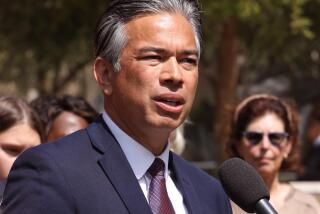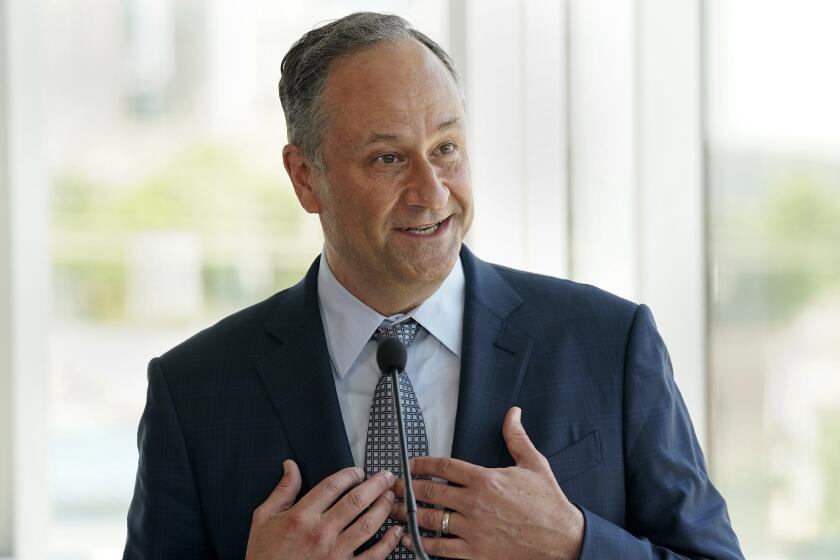Folsom Fears It Will House New Death Row
- Share via
FOLSOM, Calif. — Back when this town was just a dusty settlement on the American River, the state prison here was a big deal.
The payroll kept the economy humming, and the formidable, granite-walled lockup--immortalized in song by Johnny Cash--was a defining force and source of great local pride.
But then Folsom grew up, and along the way the prison faded almost from view, even though a new penitentiary was built next to the old one. Intel Corp. is the largest employer now, subdivisions sprawl in all directions and the historic downtown buzzes with tourists.
So it’s little wonder that members of Folsom’s social and political elite are quivering over a decision that puts the prisons squarely back in the public psyche: In a matter of months, some of death row’s most troublesome inmates will be moved here--to what is called New Folsom--from San Quentin.
The transfer was sanctioned by the Legislature because San Quentin’s 19th century design and crumbling condition are putting guards increasingly at risk. For now, no more than 15 problem inmates will move. But ultimately a new home for all 600 condemned men--and the execution chamber--must be found.
Folsom’s leaders are convinced that their prison is the favorite to host California’s new death row. And that doesn’t exactly mesh with the Chamber of Commerce vision of the city’s future.
“Having a prison here is one thing, but death row? That’s a whole different connotation,” said Phil Scott, a real estate broker and chamber president in the city of 57,000. “It’s a very strong negative, whichever way you look at it.”
State officials say a new site for death row has yet to be picked. In fact, they say they favor scattering condemned inmates among a handful of penitentiaries.
But executions must happen someplace, and they acknowledge that New Folsom, housing 3,000 prisoners in a ravine 25 miles northeast of Sacramento, is an enticing choice.
Not only is the prison equipped with a lethal electrified fence and other state-of-the-art security equipment, it is near an urban area and federal court, two advantages for defense lawyers filing last-minute appeals.
“It is a maximum-security prison that was designed and is operated to maintain some of the most violent criminals in our system,” said Stephen Green, assistant secretary of the Youth and Adult Correctional Agency.
In fact, he said, the transferred inmates will be no more dangerous than many prisoners already here. One-third of those doing time are serving life terms for murder, kidnapping or other violent crimes.
Folsom officials acknowledge that fact and say it’s not community safety they’re fretting about. The possibility of escapes, they admit, is remote.
More worrisome is the ominous specter of death row and executions and all that goes along with it--the media encampments, the emotional protests, the stigma.
Although there have been just nine men put to death since capital punishment was reinstated in California in 1977, during the last decade the pace of executions has picked up and now averages one a year.
The prisons sit just off a main boulevard, across from a residential neighborhood and a mere two-minute drive from Folsom City Hall, a playground and the zoo. Demonstrations at execution time could prove highly disruptive, officials said.
“Our residents didn’t choose to live in a town with a death row,” said City Manager Martha Clark Lofgren. “They didn’t choose to live in the home of a politically hot issue like executions and all that they bring.”
In a sense, Folsom’s anxieties reflect the struggle of a city stalked by its past. After all, Folsom Prison--opened in 1880 to relieve overcrowding at San Quentin--was for decades a home for California’s condemned.
From the first execution in 1895 to the last one 42 years later, 93 men were put to death here. Hanging was the method of choice in those days, and the executioner’s thick hemp rope is still on display--along with straitjackets, inmate-made knives and other curiosities--in the prison museum.
In 1937, the state moved all executions to San Quentin’s gas chamber.
But the prison remained a vital force in Folsom. Over the years, prison employees have been mayors, City Council members and coaches of Little League teams. Today, inmates recycle Folsom’s garbage and help clean up its parks.
The prison also is an indisputable tourist magnet, hosting more than 60,000 visitors a year. Many are drawn by its dramatic architecture, featuring a vaulted gate, Gothic-style turreted guard tower and hand-hewn walls of granite mined by inmates.
Others are lured by Cash’s foot-tapping rendition of “Folsom Prison Blues.”
“People from all over the world have heard that song and come here to see where Johnny Cash performed,” said Lt. Tom Ayers, a prison spokesman who can recite the lyrics upon request.
In 1986, the second prison was built a stone’s throw from the original. New Folsom--officially called California State Prison, Sacramento--now houses the toughest inmates, while the older lockup takes the medium-security men. Together, they are staffed by 2,200 workers, enough to make the state Department of Corrections the city’s second largest employer.
But although the prisons remain a listed “attraction” in brochures handed out to Folsom tourists, they have become for locals mostly a historical footnote, all but ignored. Though close to downtown, they are nearly invisible, tucked in the folds of rolling hills.
Far more prominent are the city’s new assets, including a thriving retail outlet mall, tony housing developments with names like Prairie Oaks, a gussied-up old town and an expanding lineup of high-tech companies.
Anchoring the industrial core is Intel, which in 1984 built an enormous research and development center that employs 7,000. Company officials say they settled in the city that calls itself “Gateway to the Gold Country” because of its friendly business climate, educated work force and great quality of life.
The prospect of adding death row to the mix has not gone over well at Intel. When the Legislature was debating whether to relocate the first group of condemned inmates, the company sent a forceful letter urging a no vote. Officials say their recruitment efforts and Folsom’s overall economic health are at risk.
“Folsom is a community that is prosperous, with outstanding schools and great opportunities for high-tech growth,” said company spokesman Bill Mueller. “And it would all be masked if Folsom develops a reputation as California’s new death row.”
That prospect took on new life this year with the bill to transfer the first batch of inmates from San Quentin, which state officials believe is no longer up to the job of housing violent, condemned inmates with nothing to lose.
San Quentin’s decrepit condition and obsolete design--dating to pre-Civil War days--mean danger for correctional officers, who have been subject to a rising number of attacks. Folsom officials do not dispute such concerns but say other maximum-security prisons, such as Pelican Bay in Crescent City or Corcoran in the San Joaquin Valley, may be better suited for death row because of their more remote locations.
That was one of several arguments Folsom made in urging lawmakers to reject the bill. Though the measure passed easily, city officials did win concessions that initially limit to 15 the number of inmates who may be moved to their town.
A review board has yet to decide which prisoners will move, but they will include known troublemakers who instigate attacks on staff members or other inmates. One man likely to be on the list is a murder convict who last year pulled a section of chain-link fence out of crumbling mortar, slipped into a staff area and attempted--unsuccessfully--to take correctional officers hostage.
Folsom leaders believe that the 15 transfers represent the proverbial camel’s nose under the tent, and some even claim that secret blueprints for a death row and execution chamber at their prison have already been drawn up. Green of the state correctional agency calls that “completely absurd,” noting that relocating death row must be authorized by the Legislature and will take years.
Green also argues that despite the uproar among Folsom’s civic leaders, everyday folks are far less sure that death row would spell doom for their town. In June, the city sent out a letter to its residents and businesses, urging them to contact the Department of Corrections and protest the death row transfers.
In response, “we got 80 contacts--e-mails, letters, phone calls,” Green said. “That doesn’t exactly represent a community up in arms.”
Richard Gray, an antiques dealer in the quaint downtown, said that’s because fellow residents haven’t yet grasped the potential consequences of hosting California’s condemned.
Sitting on a bench outside his store, the merchant--a second-generation native of Folsom--surveyed Sutter Street, bedecked with pumpkins and other festive decorations, and lamented what may come.
“How would you feel?” Gray said as a group of camera-toting tourists peered into the store he’s owned for 32 years. “Think about the image; think about property values. Would any community want to be known as the home of death row?”
More to Read
Get the L.A. Times Politics newsletter
Deeply reported insights into legislation, politics and policy from Sacramento, Washington and beyond. In your inbox twice per week.
You may occasionally receive promotional content from the Los Angeles Times.










